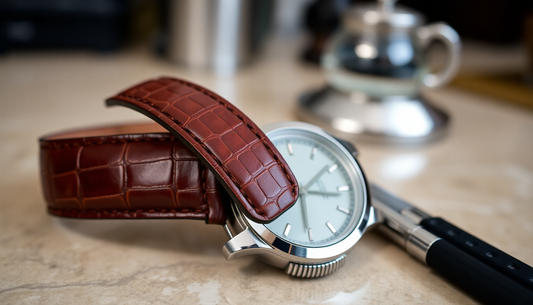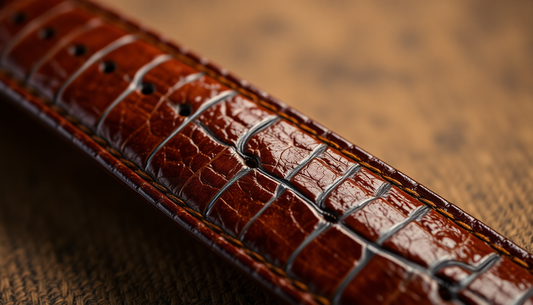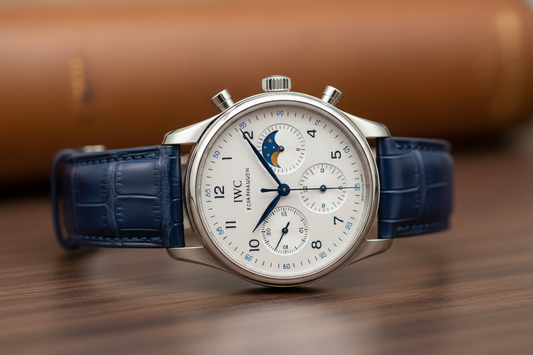Mastering the Art of Watch Band Replacement: A Comprehensive Guide for Watch Enthusiasts
Unlocking the Art of Watch Band Replacement: A Step-by-Step Guide
A watch is more than just a timekeeper; it's a statement piece that reflects your individual style. And what better way to personalize your watch than with a brand new band? Whether you're looking for a change of pace, want to match your outfit, or simply need to replace a worn-out band, mastering the art of watch band replacement is a valuable skill for any watch enthusiast.
While the idea of removing and installing spring bars might seem daunting, it's a surprisingly straightforward process. In this comprehensive guide, we'll walk you through every step, from selecting the right tools to understanding the nuances of spring bar mechanics. By the end of this article, you'll be equipped with the confidence to swap out watch bands like a pro, giving your timepiece a new lease on life.
Essential Tools for a Seamless Band Swap
Before you dive into the world of watch band replacement, ensure you have the right tools at your disposal. These tools will make the process smooth and prevent any accidental damage to your precious watch.
- **Spring Bar Tool:** This specialized tool is designed specifically to remove and install spring bars. Its unique design allows for precise pressure application, ensuring a secure and damage-free removal. A spring bar tool typically features two prongs that gently push against the spring bar, releasing it from the lug without any forceful manipulation. This gentle approach minimizes the risk of scratching or damaging your watch case.
- **Small Screwdriver (Optional):** In some cases, watch bands might be secured with tiny screws that require a small screwdriver for removal. These screws are usually located on the band's clasp or near the lugs. A small, precise screwdriver, ideally a jeweler's screwdriver, is essential for safely loosening and tightening these tiny screws.
- **New Spring Bars:** Always use spring bars that are the correct size for your watch. These small metal pins are crucial for connecting the band to the watch case. Spring bars come in various sizes, typically measured in millimeters. Using the wrong size can lead to a loose fit, accidental detachment, or even scratches on the watch case. It's essential to know the exact size needed for your watch before purchasing new spring bars.
- **Magnifying Glass (Optional):** A magnifying glass can be incredibly helpful, especially for smaller watches or when dealing with intricate spring bar mechanisms. A magnifying glass allows you to see the details of the spring bar and lug with greater clarity, ensuring precise alignment during removal and installation. This is particularly useful for watches with smaller lugs or spring bars that are difficult to manipulate with bare hands.
Understanding the Anatomy of a Spring Bar
Before we proceed with the replacement process, let's understand the basics of spring bars. Spring bars are essentially small, spring-loaded pins that connect the watch band to the lugs (the small protrusions on the watch case). These bars are designed to hold the band securely in place while allowing for easy removal.
Spring bars consist of two main parts: the bar itself and the spring mechanism. The bar is a slender, cylindrical pin with a slight bulge or bend at each end. This bulge creates a secure fit within the lugs. The spring mechanism, located within the bar, creates tension that holds the bar in place. When pressure is applied to the spring bar using a spring bar tool, the spring mechanism releases, allowing the bar to slide out of the lugs.
Spring bars come in various sizes, which are typically measured in millimeters. It's crucial to use the correct size for your watch to ensure a proper fit and prevent damage. An incorrect size could lead to loose bands or even scratches on the watch case. A larger spring bar could be too thick to fit into the lugs, potentially damaging the watch case or the spring bar mechanism. Conversely, a smaller spring bar could be too thin to hold the band securely, resulting in a loose fit and the risk of the band detaching.
Step-by-Step Guide to Replacing Your Watch Band
Now that you have the right tools and understand the basics, let's embark on the journey of replacing your watch band.
Step 1: Prepare Your Workspace
Find a clean and well-lit workspace. A soft, non-scratch surface like a microfiber cloth or a soft mat is ideal. This will protect your watch from accidental bumps and scratches. A clean workspace minimizes the risk of dust or debris getting into your watch or scratching the delicate components. A soft surface provides a cushion to prevent accidental drops or impacts that could damage the watch.
Step 2: Remove the Existing Spring Bars
This is where the spring bar tool comes into play. Position the tool between the spring bar and the watch case, ensuring the tool's prongs are aligned with the spring bar. Gently push the tool down, applying even pressure. As you push, the spring bar will gradually release from the lug. Repeat this process for the other spring bar.
**Important Tip:** Always apply pressure on the spring bar itself and not on the watch case. This will prevent damage to your watch. It's crucial to direct the pressure towards the spring bar and not the watch case.
Step 3: Remove the Old Watch Band
With both spring bars removed, your old watch band should slip off effortlessly. If you encounter any resistance, gently wiggle the band back and forth until it comes loose. This step is relatively straightforward, but if you're dealing with a stubborn band, gentle wiggling can help release any tension or friction points.
Step 4: Install the New Spring Bars
Insert one of the new spring bars into one of the lugs on the watch case. Carefully push the spring bar through the lug until it clicks into place. You'll feel a slight resistance as it snaps into position. Repeat the process for the other lug.
**Important Tip:** Be careful not to overtighten the spring bars. Applying excessive pressure can damage the spring bar mechanism or the watch case. It's crucial to apply just enough pressure to securely lock the spring bar in place. Overtightening can deform the spring bar or even scratch the lug, damaging your watch.
Step 5: Install the New Watch Band
Slide the new watch band onto the spring bars, ensuring that it's aligned correctly. Gently press the band into place to ensure a secure fit. This step involves carefully aligning the band's holes with the spring bars and gently pushing the band until it snaps into place.
Step 6: Double-Check Your Work
Before you wear your watch, double-check that the spring bars are securely in place and the watch band is properly aligned. Gently wiggle the band to ensure it's securely connected. This final check is essential to ensure the band won't come loose during wear.
Choosing the Perfect Watch Band
Once you've mastered the art of replacing your watch band, the fun truly begins! With a vast array of styles, materials, and colors to choose from, you have the power to transform the look and feel of your watch. Here are some factors to consider when selecting a new band:
- **Style:** Consider the overall style of your watch and your personal preferences. Do you prefer a classic leather strap, a sporty silicone band, or a luxurious metal bracelet? Each style brings its own unique aesthetic and functionality. Classic leather straps offer a timeless elegance, while sporty silicone bands provide durability and comfort for active lifestyles. Luxurious metal bracelets, often made of stainless steel or precious metals, exude a sophisticated and refined look.
- **Material:** The material of your watch band will impact its durability, comfort, and overall look. Leather is a timeless choice, known for its breathability and natural beauty. Metal bands offer a sleek and sophisticated touch, while silicone bands are ideal for sports and active lifestyles. Consider the level of durability you need, the comfort for your wrist, and the overall style you're aiming for.
- **Color:** The color of your watch band can complement your wardrobe or make a bold statement. Choose a color that reflects your personality and enhances the overall aesthetic of your watch. The right color can elevate your watch's appearance, matching your outfit or adding a vibrant pop of color to your ensemble.
- **Size:** Ensure that the watch band you choose fits your wrist comfortably. Measure your wrist circumference and select a band with the appropriate length. A well-fitting band ensures comfort and prevents the watch from slipping or feeling too tight.
- **Closure:** Watch bands come with various closure styles, including buckles, deployment clasps, and tang buckles. Consider the security and ease of use when choosing a closure. Buckles offer a simple and secure closure, while deployment clasps provide a more refined and elegant finish. Tang buckles are a classic option, offering simplicity and a streamlined look.
Elevate Your Watch with a Luxury Strap: Genuine Alligator Crocodile Skin Leather Deployment Strap for Cartier
For those seeking a touch of elegance and sophistication, the Genuine Alligator Crocodile Skin Leather Deployment Strap for Cartier is a perfect choice. Crafted from genuine alligator crocodile skin, this strap exudes luxury and durability, making it a statement piece for any watch enthusiast.

This exceptional strap features a deployment clasp, ensuring a secure and comfortable fit. The deployment clasp is a hallmark of high-quality watch bands, offering a more refined and elegant alternative to traditional buckle closures. It secures with a simple press of a button, eliminating the need for fiddling with buckles and providing a secure and comfortable fit.
The genuine crocodile skin used in this strap is not only incredibly luxurious but also exceptionally durable. With proper care, this strap will withstand the test of time, adding a touch of timeless elegance to your watch for years to come. The unique scales and texture of crocodile skin add a distinctive and luxurious touch to any watch. Its natural oils provide inherent water resistance, while its robust structure ensures long-lasting wear.
This strap is a perfect choice for formal occasions, adding a touch of refined luxury to your attire. Its classic design complements a wide range of watch styles, from vintage to modern, making it a versatile and timeless addition to any watch collection. Whether you're attending a gala, a business meeting, or a special event, this strap adds an element of sophistication and elegance to your ensemble.
Caring for Your Watch Band: Tips for Longevity
Once you've invested in a beautiful new watch band, it's important to care for it properly to ensure its longevity. Here are some valuable tips:
- **Clean Regularly:** Clean your watch band with a soft, damp cloth. Avoid using harsh chemicals or abrasive cleaning agents that could damage the material. Regular cleaning helps remove dirt, sweat, and grime that can accumulate on the band, preserving its appearance and extending its lifespan. Avoid using harsh chemicals or abrasives as they can strip the band of its natural oils or cause discoloration.
- **Condition Leather Bands:** Leather bands require regular conditioning to keep them soft and supple. Apply a leather conditioner to the band every few months, especially if it's exposed to dry conditions. Leather conditioner helps restore the oils and moisture in the leather, preventing it from drying out, cracking, or becoming brittle.
- **Avoid Extreme Temperatures:** Exposure to extreme temperatures can damage the material of your watch band. Avoid leaving your watch in direct sunlight or in extremely hot or cold environments. Extreme temperatures can cause leather to become brittle, crack, or lose its shape. Metal bands can expand or contract with temperature changes, potentially affecting their fit and durability.
- **Store Properly:** When not in use, store your watch band in a cool, dry place to prevent it from becoming brittle or damaged. Storing the band in a cool, dry environment helps prevent moisture buildup, which can lead to mold or mildew. Avoid storing the band in direct sunlight, as this can cause fading or discoloration.
Conclusion
Replacing your watch band is a rewarding experience that allows you to personalize your timepiece and express your unique style. By following these simple steps and understanding the fundamentals of spring bars, you can confidently swap out bands and enjoy a new look for your watch.
Whether you opt for a classic leather strap, a sporty silicone band, or a luxurious crocodile skin band like the Genuine Alligator Crocodile Skin Leather Deployment Strap for Cartier, remember to choose a band that reflects your personality and enhances your watch's overall aesthetic. With proper care and maintenance, your new watch band will add a touch of elegance and functionality to your daily routine, making every moment a stylish one.








